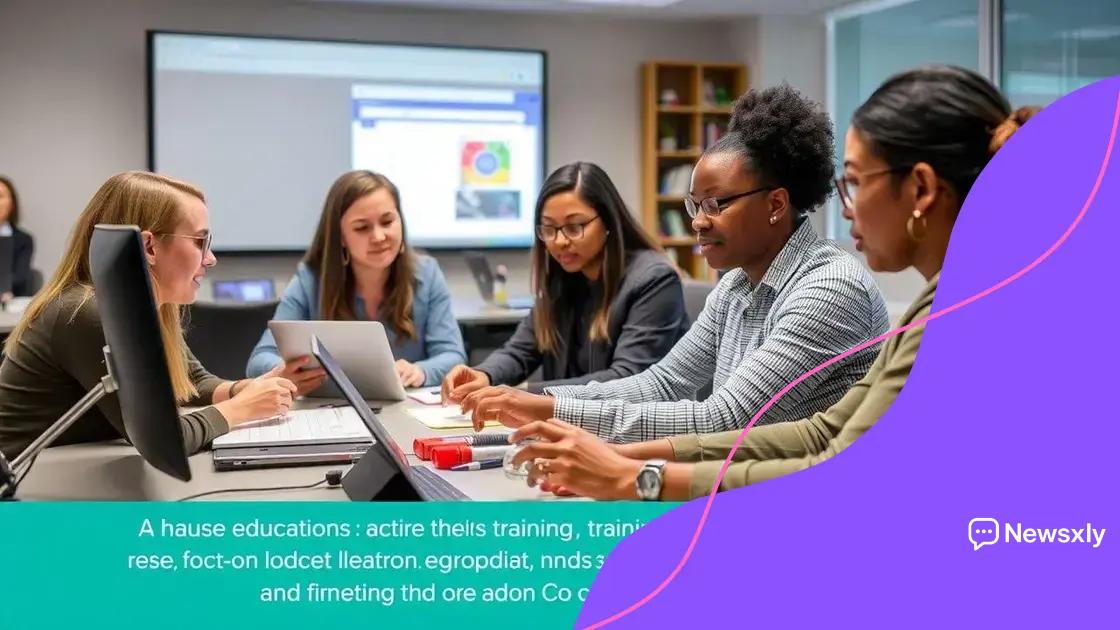Teacher professional development initiatives: Unlocking potential

Teacher professional development initiatives enhance educator skills and student outcomes through personalized learning, technology integration, collaboration, and continuous assessment, ensuring programs remain effective and relevant.
Teacher professional development initiatives are vital for enhancing teaching effectiveness and boosting student achievement. Have you ever wondered how these programs can transform the educational landscape? Let’s dive into their importance and impact.
Understanding teacher professional development
Understanding teacher professional development is crucial for enhancing educational practices. These initiatives focus on improving teachers’ skills and knowledge, ultimately benefiting students. When educators engage in meaningful professional development, they can better meet the diverse needs of their students.
What is Professional Development?
Professional development refers to various educational experiences that help teachers grow in their profession. Activities can include workshops, seminars, online courses, and collaborative projects. Engaging in these activities allows teachers to stay updated with new teaching strategies and methodologies.
Types of Professional Development
- Workshops and training sessions
- Peer collaboration and mentoring
- Online courses and resources
- Conferences and educational seminars
These opportunities enable teachers to explore innovative practices and share insights with colleagues. By doing so, they can effectively adapt their teaching to better serve their classrooms.
Moreover, teacher professional development fosters a culture of continuous learning. When educators are encouraged to grow, they often become more engaged and motivated in their teaching. This heightened enthusiasm can translate into a more dynamic learning environment for students.
Benefits of Continuous Learning
Continuing education for teachers brings numerous benefits, including improved student outcomes. When teachers enhance their skills, students receive better instruction tailored to their needs. This ultimately leads to improved academic performance.
Collaboration and Networking
Participating in professional development also promotes networking among educators. Sharing experiences and strategies can lead to new ideas and collaborative projects. Teachers who collaborate often feel more supported and less isolated in their work, which can enhance their job satisfaction.
Key benefits of professional development initiatives
Understanding the key benefits of professional development initiatives is essential for educators looking to enhance their teaching practices. These initiatives provide opportunities for teachers to grow and adapt to new challenges in the classroom. By participating in ongoing training and learning, educators can significantly impact their students’ success.
Enhanced Teaching Skills
One major benefit is the improvement in teaching skills. Professional development helps teachers acquire new techniques and methodologies. This ensures that they are well-equipped to handle various learning styles in their classrooms. As a result, students can engage better and benefit from diverse teaching approaches.
Stronger Classroom Management
- Improved strategies for behavior management
- Effective communication techniques
- Development of a positive classroom environment
- Increased student engagement
With these enhanced skills, teachers can create a more structured and supportive classroom environment. This not only benefits students but also reduces stress for teachers, leading to a more enjoyable teaching experience.
Moreover, ongoing professional development initiatives foster collaboration among educators. When teachers share their experiences and strategies, they learn from one another. This peer support can lead to innovative solutions and shared resources that benefit the entire educational community. Collaborative learning also builds a supportive network that teachers can rely on.
Increased Job Satisfaction
Another significant advantage is increased job satisfaction. When teachers feel supported and see growth in their skills, they often experience greater confidence in their abilities. This can reduce feelings of burnout and isolation. Engaging in meaningful professional development can revitalize a teacher’s passion for their career.
Improved Student Outcomes
Ultimately, the goal of these initiatives is to enhance student learning. Research shows that when teachers improve their skills, student success rates often rise. Improved teaching practices lead to higher engagement and understanding among students. Thus, investing in professional development is an investment in students’ futures.
Innovative strategies for effective training

Implementing innovative strategies for effective training is essential in professional development initiatives. These strategies not only engage teachers but also enhance their learning experiences. By introducing new methods and technologies, organizations can create more impactful training sessions that resonate with educators.
Engaging Learning Formats
One effective approach is to utilize various learning formats. Traditional lectures can be complemented with hands-on activities and interactive workshops. Incorporating group discussions and peer collaboration strengthens understanding and retention of new information. This variety keeps teachers engaged and encourages more active participation in their learning process.
Use of Technology
- Interactive online platforms for course delivery
- Webinars with expert guest speakers
- Social media groups for ongoing support
- Access to video lessons and resources
Leveraging technology allows for flexible learning options. Educators can learn at their own pace and revisit materials as needed. These tools provide instant access to a wealth of information, making training more efficient and relevant.
Another crucial strategy is to focus on real-world application. Teachers benefit greatly from training that includes practical scenarios. By addressing challenges they face in the classroom, developers can provide content that is directly applicable to their daily experiences. This relevance increases the likelihood of teachers implementing what they learn into their practice.
Mentorship Programs
Introducing mentorship programs is also effective. Pairing experienced teachers with newcomers fosters a culture of support and knowledge sharing. Mentors can provide guidance, encouragement, and feedback, which helps less experienced educators grow more confidently. This collaborative approach enhances the professional community and creates lasting relationships.
Continuous Feedback
Incorporating continuous feedback mechanisms into training is essential as well. Collecting teachers’ input on the effectiveness of training programs allows for ongoing improvement. Adjusting content based on participant feedback ensures that the training remains relevant and beneficial. By actively listening to educators, organizations can tailor their professional development efforts to better serve their needs.
Assessing the impact on educators and students
Assessing the impact on educators and students is essential in understanding the effectiveness of professional development initiatives. By measuring outcomes, schools can determine what strategies work best and how they can be improved. This evaluation directly informs future training programs and their implementation.
Measuring Educator Growth
One key aspect is to evaluate how teachers improve their skills through professional development. This can be achieved through various methods, such as performance reviews, classroom observations, and self-reflection surveys. Teachers can track their progress over time, which provides valuable insights into their growth.
Gathering Student Feedback
- Conducting student surveys about teaching methods
- Analyzing student engagement during lessons
- Tracking improvement in academic performance
- Assessing skills development and confidence
Involving students in the assessment process is also crucial. Gathering feedback from students can help educators understand how changes in teaching methods impact learning. When students feel more engaged and supported, their performance often improves. This direct feedback can indicate whether professional development has produced positive changes.
Data Analysis for Continuous Improvement
Using data analytics is another effective tool for assessing impact. Educators and administrators can analyze test scores, attendance rates, and graduation rates to identify trends. This data provides a clearer picture of how professional development affects both teacher performance and student outcomes over time.
Creating a Culture of Reflection
Additionally, fostering a culture of reflection within schools supports ongoing assessment. Encouraging teachers to share experiences and discuss challenges helps identify areas for improvement. Regularly scheduled meetings for educators to reflect on their practices can lead to meaningful changes in instruction and curriculum.
Ultimately, understanding the impact of professional development initiatives ensures that educators receive the support they need. It also enhances student learning experiences, creating a cycle of growth and improvement within the educational system.
Future trends in professional development
Understanding the future trends in professional development is crucial for educators and administrators alike. As education evolves, so do the strategies aimed at enhancing teacher effectiveness and student outcomes. Staying informed about these trends helps schools to prepare for the changes ahead.
Personalized Learning Opportunities
One emerging trend is the emphasis on personalized learning. This approach tailors professional development to meet the individual needs of educators. By assessing their skills and interests, teachers can choose training that aligns with their goals and classroom challenges. Personalized paths empower teachers and improve their engagement with the content.
Emphasis on Technology Integration
- Utilizing augmented and virtual reality in training
- Incorporating artificial intelligence tools
- Offering online and blended learning modules
- Expanding access to global resources and networks
As technology continues to influence learning, professional development will increasingly incorporate digital tools. This integration allows educators to use innovative techniques that engage students. Learning through technology enables teachers to adapt their methods based on the latest advancements, making their instruction more relevant.
Collaboration and Networking
Another significant trend is the rise of collaborative learning environments. As teachers learn from each other through peer observations and networking events, they build a supportive community. Collaboration encourages sharing best practices and can lead to improved outcomes in the classroom. Professional learning communities are becoming more common, allowing educators to grow together.
Focus on Social-Emotional Learning (SEL)
Furthermore, the increased focus on social-emotional learning in schools is shaping professional development initiatives. Understanding how to support students emotionally and socially is becoming a priority. Training that helps teachers build these skills contributes to a more positive school environment and enhances student well-being.
Finally, continuous evaluation and feedback will become more integral in shaping professional development programs. Schools will need to collect data on effectiveness routinely. This feedback loop ensures that programs remain relevant and impactful for educators and students alike.
FAQ – Frequently Asked Questions about Teacher Professional Development Initiatives
What are the key benefits of teacher professional development?
Key benefits include improved teaching skills, enhanced student outcomes, and increased job satisfaction among educators.
How can technology be integrated into professional development?
Technology can be used through online training, interactive webinars, and access to digital resources that engage teachers.
Why is collaboration important in professional development?
Collaboration fosters a supportive environment where educators share best practices and learn from each other’s experiences.
What role does assessment play in professional development?
Assessment helps evaluate the effectiveness of training, allowing educators and institutions to adjust programs for better outcomes.





